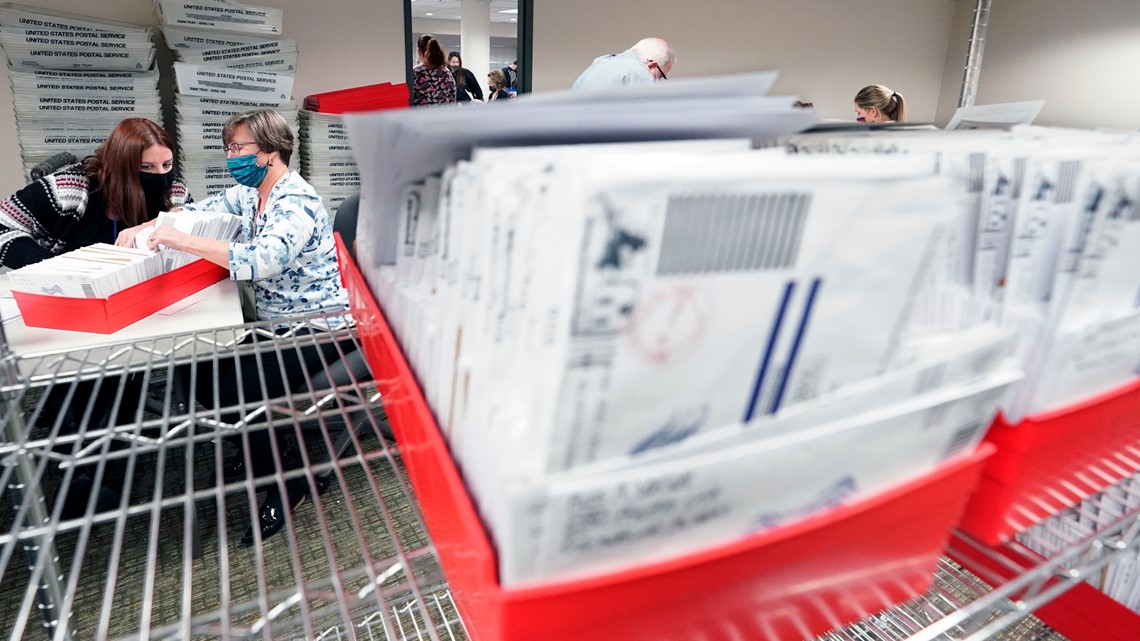Editor's note: The related video above was published Wednesday.
Viral posts have claimed that the presidential races in most states received thousands more votes than the other races on the ballots, meaning many voters submitted ballots marked only for President Donald Trump or Joe Biden and didn't make a choice in other elections.
Some claims imply that these votes favor the Democrat former vice president and could be a sign of voter fraud. They often point to swing states like Michigan as evidence.
One such claim was a tweet from a Fox contributor who said 450,000 people who voted for just Biden in “key states” were significant in assessing whether there’s evidence of fraudulent ballots.
But this kind of suspicion on these ballots ignores the history of undervoting in American elections.
THE QUESTION
Are ballots that only had votes for Trump or Biden, and no candidates from other races, evidence of election fraud?
THE ANSWER
No. That kind of voting, called undervoting, is extremely common in U.S. elections. It happened in states that usually favor Republicans as well as those that lean Democratic, and among voters for both candidates.
WHAT WE FOUND
The Federal Election Commission has a page of past results and vote totals for American elections, including tables that show how many people voted for president, senator and representative in the House.
While not every voter in any given election has an opportunity to vote for a senator, every voter does get a chance to vote for a member of the House. Undervoting can be measured by comparing past nationwide presidential vote totals to past House of Representatives totals.
In 2016, 136,669,276 voted for president while only 131,652,458 voted for a member of the House. In 2012, 129,085,410 voted for president while only 124,793,115 voted for a Congress member. In 2008, 131,313,820 voted for president while only 122,959,841 voted for a House representative. And in 2004, 122,295,345 voted for president while only 114,413,842 voted for a House member.
That data does show some variation. While fewer people voted in the presidential election in 2012 than they did in 2008, more voted for a representative in Congress. While the number of voters who undervoted hovered around 8 million in 2004 and 2008, that number reduced to about 5 million in 2012 and 2016.
It’s also a very informal analysis of undervoting. Just because someone didn’t vote for a congressperson doesn’t mean they also didn’t vote in other races like those for Senate, state governor, city council or other posts. However, it helps in very clearly highlighting that there are people who vote for president while ignoring other races.
Tallies from this year’s election so far show that 2020 was no different. In Michigan, which was one state scrutinized for the discrepancy, 5,526,912 voted for president and only 5,467,094 voted for Senate. That’s a difference of about 60,000 votes. Biden ran about 70,000 votes ahead of the Democratic Senate candidate, Trump ran about 7,000 votes ahead of the Republican, and third party candidates for president actually got 20,000 less votes than third party Senate candidates.
But both undervoting and presidential candidates running ahead of their party’s Senate candidate happened in plenty of other states, including other swing states, safe states, and states that voted for Trump over Biden.
In Kentucky, for example, 2,134,996 people voted for president versus 2,134,446 who voted for Senate. That’s an undercount of only 500 votes. But despite that, Trump ran ahead of Republican Sen. Mitch McConnell by about 93,000 votes and Biden finished with about 44,000 votes less than Kentucky’s Democratic Senate candidate.
Virginia, a state that went in Biden’s favor, had a more significant undercount of 55,349 votes. But Virginia’s Democratic Senate candidate finished with over 50,000 votes more than Biden while the Republican president finished with just under 30,000 votes more than Virginia’s GOP Senate candidate.


Another swing state, Texas, had more than 160,000 people vote in the presidential election but not the election for the state’s Senate seat. Despite that, Texas’ Republican Senate candidate won about 70,000 more votes than Trump while Biden won more than 350,000 more votes than the Democratic Senate candidate.
Those comparisons are all to say that undervoting is common -- North Carolina’s incomplete results also show a significant undervote with both presidential candidates gaining significantly more votes than the Senate candidates -- but the outcomes of the undervote aren’t consistent across the board. In fact, while undervoting is common it isn’t even universal as more people voted for the Senate than for president in South Carolina. The Democratic Senate candidate outperformed Biden while Trump outperformed the Republican Senate candidate in that state.
Once again, you can vote for president, ignore the Senate, and then vote in other races. However, comparisons between presidential vote counts and Senate vote counts show people can be selective about what races they vote in.
Furthermore, the federal Cybersecurity and Infrastructure Security Agency, also called CISA, has included these concerns on its rumor control webpage. CISA says undervoting occurs every election.
Given the documented history of undervoting, it’s much more likely that these discrepancies can be explained by people who voted only for president, rather than people stuffing ballot boxes with fake votes for Biden and no other candidate.
Something you’d like VERIFIED? Click here to submit your story.

